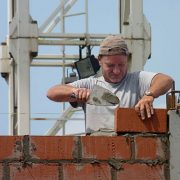Access Equipment Jobs: Mason/Bricklayer
Bricklayers and stonemasons depend on various types of access equipment, and Force is proud to offer a wide variety of equipment to suit nearly every job. Today, we’re explaining what bricklayers do and highlighting some key skills used in this field.
Before You Touch That Brick…
There’s a lot more that goes on besides physical labour. Bricklayers have to be able to understand architectural plans and work out the details of the jobs themselves. They must determine the materials and equipment needed for installation, based on the environment and dimensions of the job. Competence in maths is definitely a bonus in the mason’s trade.
Before even touching a trowel, bricklayers and stonemasons need to prep their materials. Sometimes this means polishing stones or shaping bricks. There are even jobs that require stones be cut into specific shapes, letters, or designs. A steady hand and artistic aptitude are huge pluses.
On The Job…
While you may occasionally use access equipment such as scissor lifts, particularly for jobs like repointing, most often bricklayers do construction work from scaffolding. They have to be able to put scaffolding together and take it down upon completion of a job. Obviously, as you’ll sometimes be working off the ground, a fear of heights doesn’t fit well with a career in masonry.
You’ll have to be able to lay stones and bricks in a variety of designs and patterns, using proper spacing and the appropriate amount of mortar. This requires constant monitoring of the overall ‘big picture’, checking alignment and referencing your plans to make sure you’re on track. Inevitably, you will run into tight corners and other geometric imperfections; bricklayers and stonemasons sometimes have to be creative trouble shooters.
Flex Your Muscles And Your Mind…
Of course, a lot of masonry work involves constructing large, heavy walls. Although you might be using access equipment like telehandlers to help manoeuvre materials, it’s still important to be physically healthy and strong.
You’ll also need to have knowledge of access equipment and how to operate it safely. Slabs for large projects can weigh several tonnes, and it’s critical you select the right access equipment for the job. It’s important to keep in mind not just the materials you are working with, but the space you are working in and the limitations of the equipment. What are the ground conditions? How many people are working in the same area? What do the materials weigh, and what’s the maximum load that the access equipment can handle? Critical thinking skills are very important for working safely as a mason.
Getting Started…
If this sounds like the right job for you, you’ll need to start by attaining a Certificate III/IV. While not always necessary, more than half of Australian bricklayers have that qualification. In most parts of Australia, you’ll have to go through an apprenticeship or training programme to become officially licensed. Check with the trade organisation of government website in your region to find outs the specifics.



